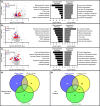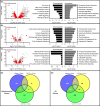Eicosapentaenoic acid but not docosahexaenoic acid restores skeletal muscle mitochondrial oxidative capacity in old mice
- PMID: 26010060
- PMCID: PMC4568961
- DOI: 10.1111/acel.12352
Eicosapentaenoic acid but not docosahexaenoic acid restores skeletal muscle mitochondrial oxidative capacity in old mice
Abstract
Mitochondrial dysfunction is often observed in aging skeletal muscle and is implicated in age-related declines in physical function. Early evidence suggests that dietary omega-3 polyunsaturated fatty acids (n-3 PUFAs) improve mitochondrial function. Here, we show that 10 weeks of dietary eicosapentaenoic acid (EPA) supplementation partially attenuated the age-related decline in mitochondrial function in mice, but this effect was not observed with docosahexaenoic acid (DHA). The improvement in mitochondrial function with EPA occurred in the absence of any changes in mitochondrial abundance or biogenesis, which was evaluated from RNA sequencing, large-scale proteomics, and direct measurements of muscle mitochondrial protein synthesis rates. We find that EPA improves muscle protein quality, specifically by decreasing mitochondrial protein carbamylation, a post-translational modification that is driven by inflammation. These results demonstrate that EPA attenuated the age-related loss of mitochondrial function and improved mitochondrial protein quality through a mechanism that is likely linked with anti-inflammatory properties of n-3 PUFAs. Furthermore, we demonstrate that EPA and DHA exert some common biological effects (anticoagulation, anti-inflammatory, reduced FXR/RXR activation), but also exhibit many distinct biological effects, a finding that underscores the importance of evaluating the therapeutic potential of individual n-3 PUFAs.
Keywords: aging; docosahexaenoic acid; eicosapentaenoic acid; mitochondria; omega 3; proteomics; sarcopenia.
© 2015 The Authors. Aging Cell published by the Anatomical Society and John Wiley & Sons Ltd.
Figures




Similar articles
-
Differential effects of EPA and DHA on aging-related sarcopenia in mice and possible mechanisms involved.Food Funct. 2025 Jan 20;16(2):601-616. doi: 10.1039/d4fo04341c. Food Funct. 2025. PMID: 39704327
-
EPA and DHA elicit distinct transcriptional responses to high-fat feeding in skeletal muscle and liver.Am J Physiol Endocrinol Metab. 2019 Sep 1;317(3):E460-E472. doi: 10.1152/ajpendo.00083.2019. Epub 2019 Jul 2. Am J Physiol Endocrinol Metab. 2019. PMID: 31265326 Free PMC article.
-
Effects of intermittent dietary supplementation with conjugated linoleic acid and fish oil (EPA/DHA) on body metabolism and mitochondrial energetics in mice.J Nutr Biochem. 2018 Oct;60:16-23. doi: 10.1016/j.jnutbio.2018.07.001. Epub 2018 Jul 5. J Nutr Biochem. 2018. PMID: 30041048
-
The role of omega-3 polyunsaturated fatty acids eicosapentaenoic and docosahexaenoic acids in the treatment of major depression and Alzheimer's disease: Acting separately or synergistically?Prog Lipid Res. 2016 Apr;62:41-54. doi: 10.1016/j.plipres.2015.12.003. Epub 2016 Jan 4. Prog Lipid Res. 2016. PMID: 26763196 Review.
-
Nutrition as the foundation for successful aging: a focus on dietary protein and omega-3 polyunsaturated fatty acids.Nutr Rev. 2024 Feb 12;82(3):389-406. doi: 10.1093/nutrit/nuad061. Nutr Rev. 2024. PMID: 37319363 Review.
Cited by
-
Omega-3 Polyunsaturated Fatty Acids Mitigate Palmitate-Induced Impairments in Skeletal Muscle Cell Viability and Differentiation.Front Physiol. 2020 Jun 3;11:563. doi: 10.3389/fphys.2020.00563. eCollection 2020. Front Physiol. 2020. PMID: 32581844 Free PMC article.
-
Effects of aging on mitochondrial function in skeletal muscle of American American Quarter Horses.J Appl Physiol (1985). 2016 Jul 1;121(1):299-311. doi: 10.1152/japplphysiol.01077.2015. Epub 2016 Jun 9. J Appl Physiol (1985). 2016. PMID: 27283918 Free PMC article.
-
Potential Role of Omega-3 Fatty Acids on the Myogenic Program of Satellite Cells.Nutr Metab Insights. 2016 Feb 3;9:1-10. doi: 10.4137/NMI.S27481. eCollection 2016. Nutr Metab Insights. 2016. PMID: 26884682 Free PMC article. Review.
-
Balanced Diet-Fed Fat-1 Transgenic Mice Exhibit Lower Hindlimb Suspension-Induced Soleus Muscle Atrophy.Nutrients. 2017 Oct 6;9(10):1100. doi: 10.3390/nu9101100. Nutrients. 2017. PMID: 28984836 Free PMC article.
-
Marine Lipids on Cardiovascular Diseases and Other Chronic Diseases Induced by Diet: An Insight Provided by Proteomics and Lipidomics.Mar Drugs. 2017 Aug 18;15(8):258. doi: 10.3390/md15080258. Mar Drugs. 2017. PMID: 28820493 Free PMC article. Review.
References
-
- Balagopal P, Rooyackers OE, Adey DB, Ades PA, Nair KS. Effects of aging on in vivo synthesis of skeletal muscle myosin heavy-chain and sarcoplasmic protein in humans. Am. J. Physiol. 1997;273:E790–E800. - PubMed
-
- Balagopal P, Schimke JC, Ades P, Adey D, Nair KS. Age effect on transcript levels and synthesis rate of muscle MHC and response to resistance exercise. Am. J. Physiol. Endocrinol. Metab. 2001;280:E203–E208. - PubMed
-
- Belcastro AN, Arthur GD, Albisser TA, Raj DA. Heart, liver, and skeletal muscle myeloperoxidase activity during exercise. J. Appl. Physiol. Bethesda Md 1985. 1996;80:1331–1335. - PubMed
-
- Coggan AR, Spina RJ, King DS, Rogers MA, Brown M, Nemeth PM, Holloszy JO. Skeletal muscle adaptations to endurance training in 60- to 70-yr-old men and women. J. Appl. Physiol. Bethesda Md 1985. 1992;72:1780–1786. - PubMed
Publication types
MeSH terms
Substances
Grants and funding
LinkOut - more resources
Full Text Sources
Other Literature Sources
Medical
Research Materials

